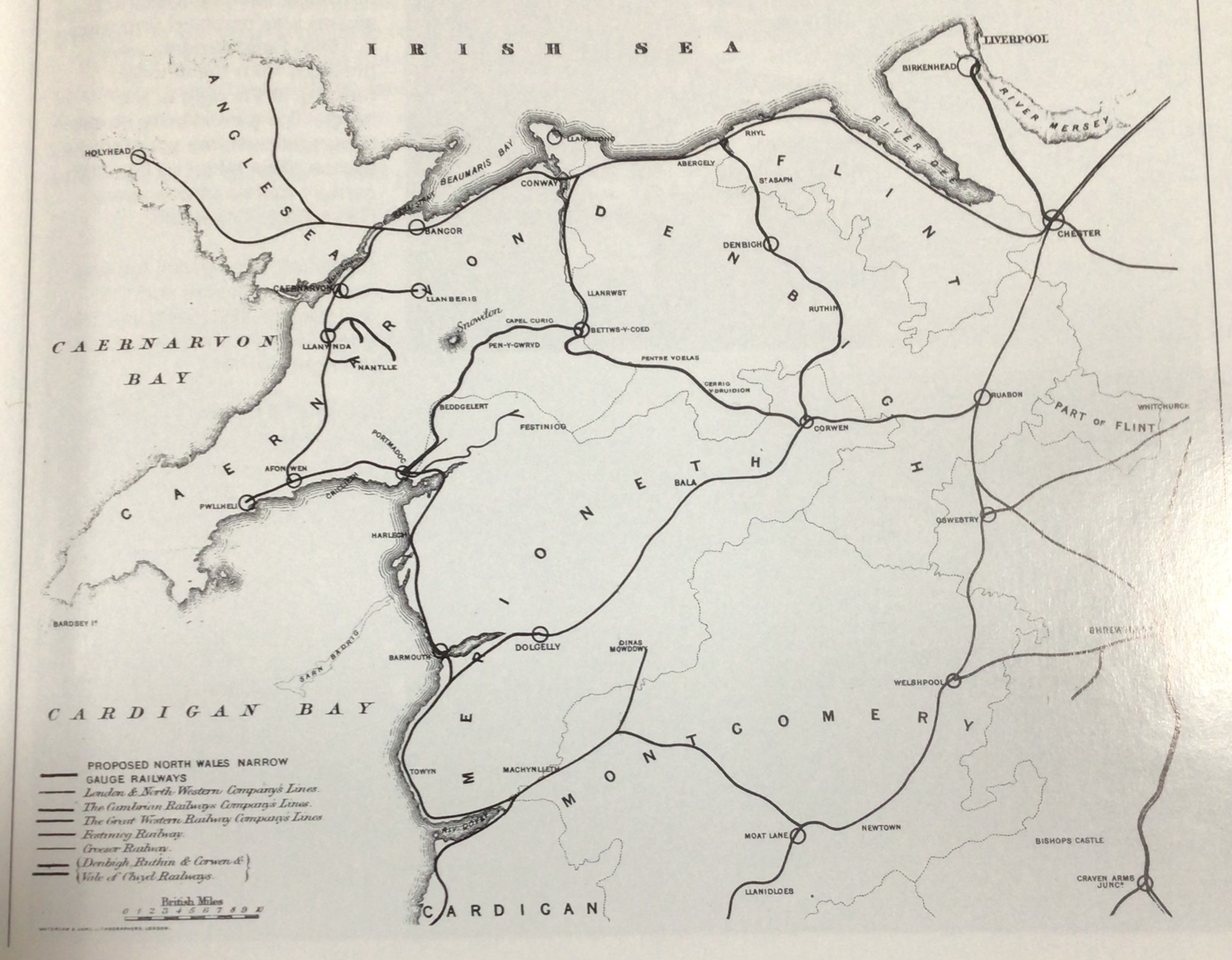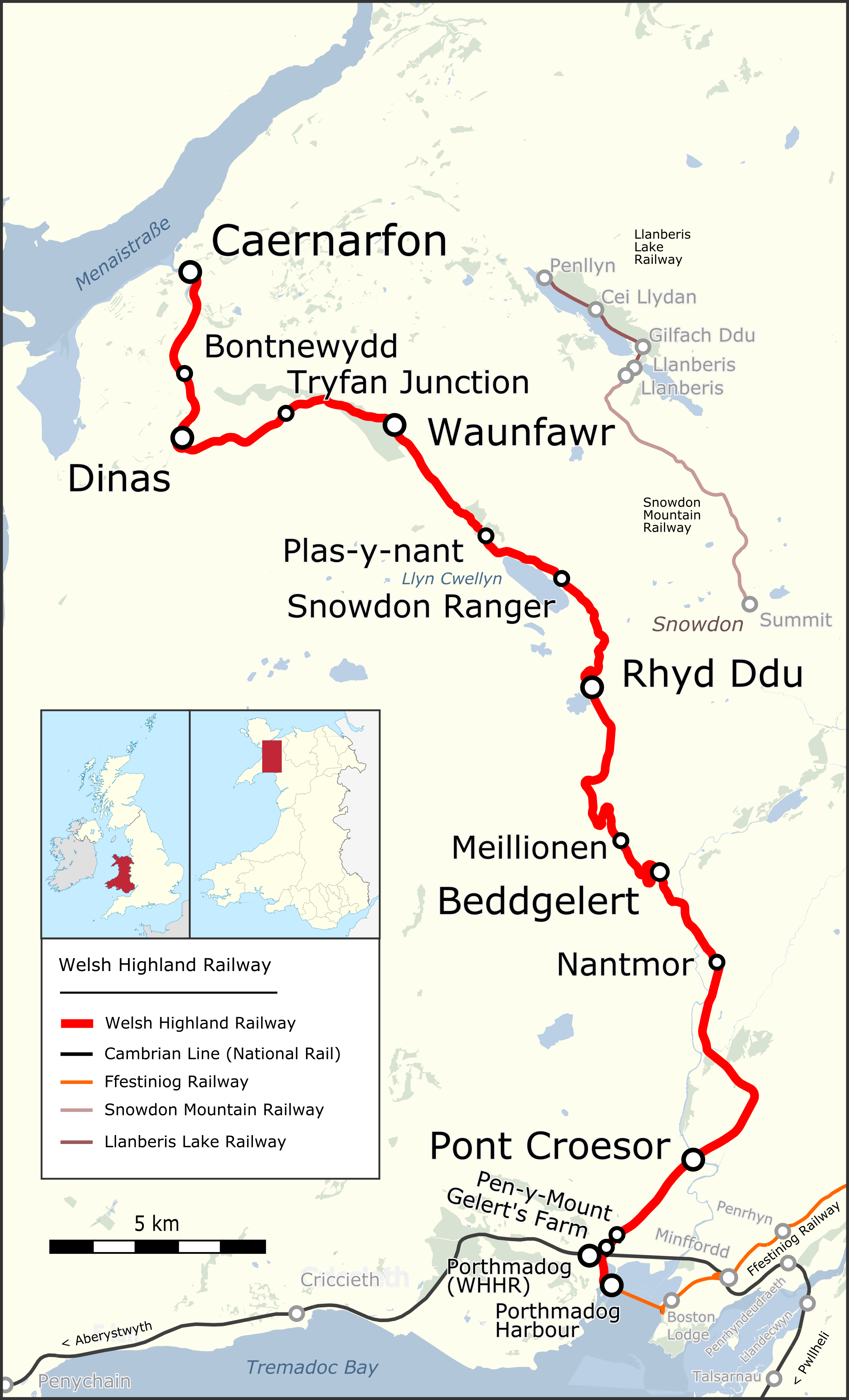|
Rhostryfan Railway Station
Rhostryfan railway station was the intermediate station on the Bryngwyn Branch of the North Wales Narrow Gauge Railways (NWNGR) and its successor the Welsh Highland Railway (WHR). At some time since closure, the station itself has been demolished. Although the line from Tryfan Junction to Bryngwyn has been purchased by the Festiniog Railway Company, there are no immediate plans to reopen the line. In 2011 the trackbed of the line became a public footpath, although with the condition that this would not impede any reopening of the branch line in the future. See also * North Wales Narrow Gauge Railways The North Wales Narrow Gauge Railways (NWNGR) was a railway company that planned to build a number of inter-connected narrow-gauge railways across North Wales. The first two of these lines - jointly known as the "Moel Tryfan Undertaking" - were ... References External links Welsh Highland History, The Bryngwyn Branch {{WHR Disused railway stations in Gwynedd ... [...More Info...] [...Related Items...] OR: [Wikipedia] [Google] [Baidu] |
Rhostryfan
Rhostryfan is a place 4 miles from Caernarfon, in the community of Llanwnda, in the principal area of Gwynedd, Wales. In 2020 it had an estimated population of 722. It was formerly served by Rhostryfan railway station Rhostryfan railway station was the intermediate station on the Bryngwyn Branch of the North Wales Narrow Gauge Railways (NWNGR) and its successor the Welsh Highland Railway (WHR). At some time since closure, the station itself has been demolis .... History The "Rhos" part of the name means "a moor", the "tryfan" part means "high place".Place-Names in Wales - Forgotten Books References External links * Villages in Gwynedd Llanwnda, Gwynedd {{Gwynedd-geo-stub ... [...More Info...] [...Related Items...] OR: [Wikipedia] [Google] [Baidu] |
Gwynedd
Gwynedd (; ) is a Local government in Wales#Principal areas, county and preserved county (latter with differing boundaries; includes the Isle of Anglesey) in the North West Wales, north-west of Wales. It shares borders with Powys, Conwy County Borough, Denbighshire, Anglesey over the Menai Strait, and Ceredigion over the River Dyfi. The scenic Llŷn Peninsula and most of Snowdonia National Park are in Gwynedd. Bangor, Gwynedd, Bangor is the home of Bangor University. As a Administrative divisions of Wales, local government area, it is the second largest in Wales in terms of land area and also one of the most sparsely populated. A majority of the population is Welsh language, Welsh-speaking. ''Gwynedd'' also refers to being one of the preserved counties of Wales, covering the two local government areas of Gwynedd and Anglesey. Named after the old Kingdom of Gwynedd, both culturally and historically, ''Gwynedd'' can also be used for most of North Wales, such as the area that was p ... [...More Info...] [...Related Items...] OR: [Wikipedia] [Google] [Baidu] |
North Wales Narrow Gauge Railways
The North Wales Narrow Gauge Railways (NWNGR) was a railway company that planned to build a number of inter-connected narrow-gauge railways across North Wales. The first two of these lines - jointly known as the "Moel Tryfan Undertaking" - were authorised by Act of Parliament 1872 and were built and opened in the 1870s. The original main line ran from Dinas Junction to Bryngwyn and opened in 1877. The second line was a branch from Tryfan Junction to South Snowdon, though shortly after opening, the company designated the Tryfan Junction to Bryngwyn section as the branch, and the Dinas Junction to South Snowdon section as the main line. Routes built The company completed construction of two lines, The first, opened in 1877, was approximately long, running south-east from a junction with the London and North Western Railway's Caernarfon to Afon Wen branch at , to . There were intermediate stations at and . From Bryngwyn, a shallow incline climbed the northern flank of Moel Tr ... [...More Info...] [...Related Items...] OR: [Wikipedia] [Google] [Baidu] |
Welsh Highland Railway
The Welsh Highland Railway (WHR) or Rheilffordd Eryri is a long, restored narrow gauge heritage railway in the Welsh county of Gwynedd, operating from Caernarfon to Porthmadog, and passing through a number of popular tourist destinations including Beddgelert and the Aberglaslyn Pass. At Porthmadog it connects with the Ffestiniog Railway and to the short Welsh Highland Heritage Railway. In Porthmadog it uses the United Kingdom's only mixed gauge flat rail crossing. The restoration, which had the civil engineering mainly built by contractors and the track mainly built by volunteers, received a number of awards. Originally running from , near Caernarfon, to ,Boyd (1972), pages=283 the current line includes an additional section from Dinas to Caernarfon. The original line also had a branch to and the slate quarries around Moel Tryfan, which has not been restored. (This branch forms a footpath "rail trail", the lower section of which has been resurfaced and supplied with her ... [...More Info...] [...Related Items...] OR: [Wikipedia] [Google] [Baidu] |
Bryngwyn Railway Station
Bryngwyn railway station is a former station which was the terminus for passengers on the Bryngwyn Branch of the North Wales Narrow Gauge Railways, and later the Welsh Highland Railway. Beyond the station, an incline climbed the slope of Moel Tryfan to serve a series of slate quarries. Those connected by tramways to the incline head included the Alexandra quarry, Moel Tryfan quarry, Fron quarry, Braich quarry and Cilgwyn quarry. History At Bryngwyn a 1 in 10 balanced incline owned by the Welsh Highland Railway led to an upper plateau from where quarry owned lines radiated to several slate quarries in the Moel Tryfan and Nantlle area. Although slate traffic continued as required until final closure in 1936, passenger trains ceased to operate on the branch in 1914. There is very little left of the original Bryngwyn station today, which would have stood in the middle of fields near a farm where the station takes its name. The station consisted of a typical North Wales Narrow Ga ... [...More Info...] [...Related Items...] OR: [Wikipedia] [Google] [Baidu] |
Festiniog Railway Company
The Ffestiniog Railway ( cy, Rheilffordd Ffestiniog) is a heritage railway based on narrow-gauge, located in Gwynedd, Wales. It is a major tourist attraction located mainly within the Snowdonia National Park. The railway is roughly long and runs from the harbour at Porthmadog to the slate mining town of Blaenau Ffestiniog, travelling through forested and mountainous terrain. The line is single track throughout with four intermediate passing places. The first mile of the line out of Porthmadog runs atop an embankment called ''the Cob'', which is the dyke of the polder known as Traeth Mawr. The Festiniog Railway Company, which owns the railway, is the oldest surviving railway company in the world. It also owns the Welsh Highland Railway, which was re-opened fully in 2011. The two railways share the same track gauge and meet at Porthmadog station, with occasional trains working the entire route from Blaenau Ffestiniog to Caernarfon. History The railway company is properly k ... [...More Info...] [...Related Items...] OR: [Wikipedia] [Google] [Baidu] |
Railway Stations In Great Britain Opened In 1877
Rail transport (also known as train transport) is a means of transport that transfers passengers and goods on wheeled vehicles running on rails, which are incorporated in tracks. In contrast to road transport, where the vehicles run on a prepared flat surface, rail vehicles (rolling stock) are directionally guided by the tracks on which they run. Tracks usually consist of steel rails, installed on sleepers (ties) set in ballast, on which the rolling stock, usually fitted with metal wheels, moves. Other variations are also possible, such as "slab track", in which the rails are fastened to a concrete foundation resting on a prepared subsurface. Rolling stock in a rail transport system generally encounters lower frictional resistance than rubber-tyred road vehicles, so passenger and freight cars (carriages and wagons) can be coupled into longer trains. The operation is carried out by a railway company, providing transport between train stations or freight customer facilit ... [...More Info...] [...Related Items...] OR: [Wikipedia] [Google] [Baidu] |


